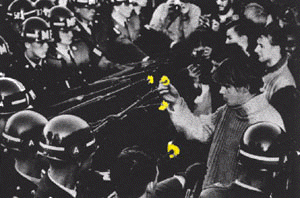An FBI Plot that Backfired

|
On October 21, 1967, seventy-five thousand protesters assembled at the Lincoln
Memorial, including a sizable number of hippie types dressed in colorful costumes. The
motley army of witches, warlocks, sorcerers, and long-haired bards who had come to
celebrate the mystic revolution lent a carnival atmosphere to the demonstration. After a
rousing prelude of speeches and songs, a large contingent crossed the Arlington
Memorial Bridge into Virginia and raced toward the Pentagon, waving banners and
shouting antiwar epithets. Some were high on acid when they stormed the grim
ziggurat. They surrounded the entire building, dancing and hissing in unison, while
soldiers stood guard at all five walls. Posters and slogans memorializing Che Guevara,
the Latin revolutionary who had been killed in Bolivia a few weeks earlier, appeared on
abutments, and a Viet Cong flag, blue and red with a gold star, fluttered in the breeze.
And then the promised exorcism began. "Out, demons, out!" boomed the voice of Ed Sanders, leader of a burlesque folk-rock ensemble called the Fugs, which provided musical edification for the antiwar constituency. On a flatbed truck in front of the high church of the military-industrial complex, the Fugs worked their "gene-shredding influence" on the crowd. Thousands shrieked their approval--"Out, out, out!"--and the stage was set for an ecstatic confrontation. The demonstration had become a form of ritual theater, a preview of what politics would be like in the post-Haight-Ashbury era. As Norman Mailer wrote in The Armies of the Night, a best selling account of the march on the Pentagon, "Now, here, after several years of the blandest reports from the religious explorers of LSD, vague Tibetan lama goody-goodness auras of religiosity being the only publicly announced or even rumored fruit from all trips back from the buried Atlantis of LSD, now suddenly an entire generation of acid-heads seemed to have said goodbye to easy visions of heaven, no, now the witches were here, and rites of exorcism, and black terrors of the night...The hippies had gone from Tibet to Christ to the Middle Ages, now they were Revolutionary Alchemists." Despite their incantations and spells the protesters could not transmute the lead weight of the Pentagon into a golden vision in the sky. But it hardly mattered, for they were celebrating a new kind of activism, a style so authentically unique that it verged on the bizarre. "What possibly they shared," said Mailer, "was the unspoken happy confidence that politics had again become mysterious, had begun to partake of Mystery ...The new generation believed in technology more than any before it, but the generation also believed in LSD, in witches, in tribal knowledge, in orgy, and revolution. It had no respect whatsoever for the unassailable logic of the next step: belief was reserved for the revelatory mystery of the happening where you did not know what was going to happen next; that was what was good about it." What happened next was not something anyone had expected--in fact, it might never have happened had it not been for the FBI, which attempted to disrupt the antiwar gathering upon learning of a plot to sky-bomb the Pentagon with ten thousand flowers. Peggy Hitchcock (the sister of William Mellon Hitchcock, owner of the Millbrook estate) gave Michael Bowen and friends money to purchase two hundred pounds of daisies for the occasion, but the plan never got off the ground because of a dirty trick by the FBI. J. Edgar Hoover's men answered an ad for a pilot in the East Village Other but never showed up at the airport. Bowen was stuck with more flowers than he knew what to do with, so he turned around and drove back to the demonstration. Distributed among the crowd, the flowers were subsequently photographed by the world press protruding from the muzzles of rifles held by the soldiers guarding the Pentagon. It was one of the spectacular images of the 1960s: the troops with their bayonets sprouting daisies, frozen in a tense face-off with the antiwar activists. |
An excerpt from Acid Dreams: The Complete Social History of
LSD: The CIA, the Sixties and Beyond, by Martin A. Lee and Bruce Shlain
(Grove Press)
Copyright 1985 by Martin A. Lee and Bruce Shlain
The Acid Dreams web site: http://www.levity.com/aciddreams/